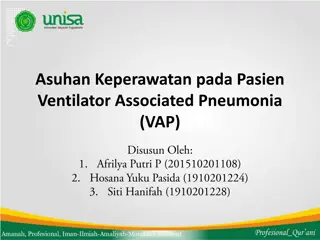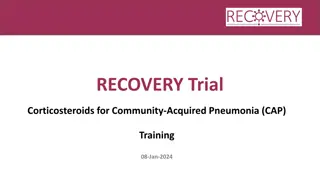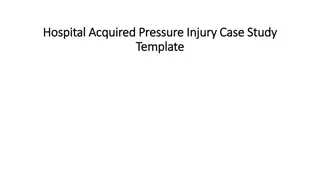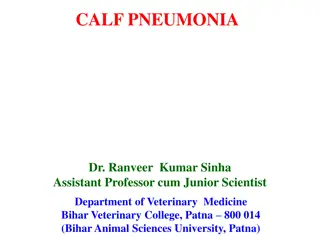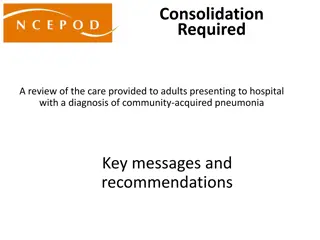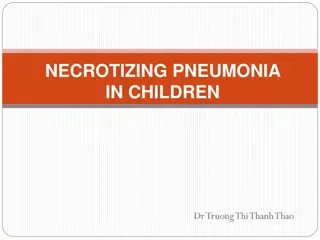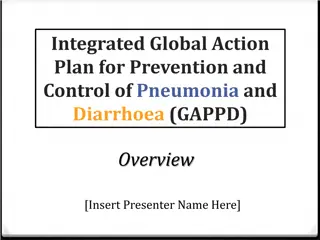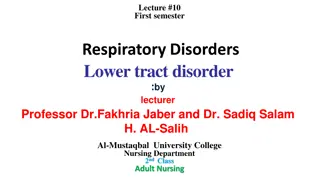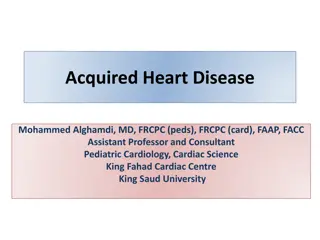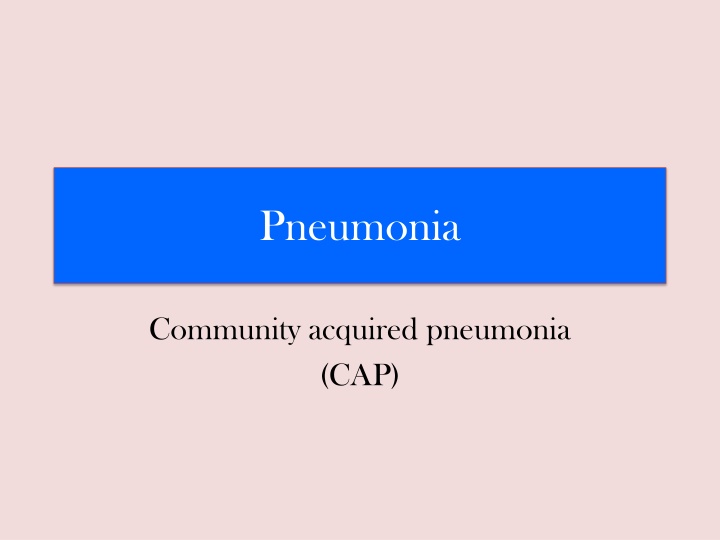
Pneumonia and Community-Acquired Pneumonia (CAP)
Explore the epidemiology, pathophysiology, clinical presentations, diagnosis, treatment, and common etiological agents of pneumonia and CAP. Learn about the risk factors, mortality rates, and defense mechanisms of the respiratory tract. Dive into the different classifications of pneumonia, including infectious and non-infectious agents. Discover the pathogenesis of pneumonia and the mechanisms involved in its formation. Gain insights into the prevention of Streptococcus pneumoniae and the overall impact of pneumonia on public health.
Download Presentation

Please find below an Image/Link to download the presentation.
The content on the website is provided AS IS for your information and personal use only. It may not be sold, licensed, or shared on other websites without obtaining consent from the author. If you encounter any issues during the download, it is possible that the publisher has removed the file from their server.
You are allowed to download the files provided on this website for personal or commercial use, subject to the condition that they are used lawfully. All files are the property of their respective owners.
The content on the website is provided AS IS for your information and personal use only. It may not be sold, licensed, or shared on other websites without obtaining consent from the author.
E N D
Presentation Transcript
Pneumonia Community acquired pneumonia (CAP)
Objectives Discuss the epidemiology and pathophysiology of pneumonia and CAP Explain the different classifications of pneumonia Recognize clinical presentations associated with CAP Discuss the diagnosis and treatment of CAP Identify common etiological agents causing CAP and discuss their laboratory work up Discuss virulence factors and prevention of Streptococcus pneumoniae
Definition Pneumonia is an infection that leads to inflammation of the parenchyma of the lung (the alveoli) (consolidation and exudation) It may present as acute, fulminant clinical disease or as a chronic disease with a more prolonged course
Epidemiology Risk factors Risk factors Age < 2 yrs, > 65 yrs Alcoholism Smoking Asthma and COPD Aspiration Dementia Prior influenza HIV Immunosuppression Institutionalization Recent hotel : Legionella Travel, pets, occupational exposures- birds (C. psittaci) Overall the rate of CAP 5-6 cases per 1000 persons per year Mortality 23% High, especially in old people Almost 1 million annual episodes of CAP in adults > 65 yrs in the US
Etiological agents Infectious: Bacterial Fungal Viral Parasitic Non-infectious like: Chemical Allergen related
Pathogenesis Two factors involved in the formation of pneumonia Pathogens Host defenses.
Defense mechanism of respiratory tract Filtration and deposition of environmental pathogens in the upper airways Cough reflux Mucociliary clearance Alveolar macrophages Humoral and cellular immunity Oxidative metabolism of neutrophils
Pathophysiology 1. Inhalation or aspiration of pulmonary pathogenic organisms into a lung segment or lobe. 2. Results from secondary bacteraemia from a distant source, such as Escherichia coli urinary tract infection and/or bacteraemia (less commonly). 3. Aspiration of oropharyngeal contents (multiple pathogens).
Classification Pneumonia classified according to: Pneumonia classified according to: 1. Pathogen Bacterial Typical Atypical Viral Fungal Parasite 2. Anatomy 3. Acquired environment
Classification by anatomy Classification by anatomy 1. Lobar Lobar: : entire 2. Lobular Lobular: : (bronchopneumonia) (bronchopneumonia). . 3. Interstitial Interstitial entire lobe lobe
Classification by acquired environment Community acquired pneumonia (CAP) Hospital acquired pneumonia (HAP) Nursing home acquired pneumonia (NHAP)
CAP-fever+ productive cough + infiltrate CAP CAP : pneumonia acquired outside of hospitals or extended-care facilities Typical Atypical Strept. pneumoniae (lobar pneumonia) Haemophilus influenzae Moraxella catarrhalis S. aureus Gram-negative organisms Atypical: not detectable on gram stain; won t grow on standard media Mycoplasma pneumoniae Chlamydia pneumoniae Legionella pneumophila
Community acquired pneumonia Strep pneumonia 48% Viral 23% Atypical orgs (MP,LG,CP) 22% Haemophilus influenza 7% Moraxella catharralis 2% Staph aureus 1.5% Gram ive orgs 1.4% Anaerobes
Typical pneumonia Typical pneumonia Clinical manifestation The onset is acute Prior viral upper respiratory infection Respiratory symptoms Fever Shaking chills Cough with sputum production (rusty-sputum) Chest pain- or pleurisy Shortness of breath
Diagnosis Clinical History & physical X-ray examination Laboratory CBC- leukocytosis Sputum Gram stain- 15% Culture Blood culture-5-14% Pleural effusion gram + culture Pneumococcal pneumonia Pneumococcal pneumonia
Streptococcus pneumoniae Gram positive diplococci Alpha hemolytic streptococci Catalase negative Normal flora of upper respiratory tract in 20- 40% of people Causes: Resp infections pneumonia, sinusitis, otitis, Non resp infections bacteremia, meningitis
Streptococcus pneumoniae Virulence factors: Capsule More than 90 capsular types Pneumolysin Autolysin Neuraminidase Prevention: vaccination
Streptococcus pneumoniae Sensitive to Optochin Lysed by bile (bile soluble)
Atypical pneumonia Chlamydia pneumonia Approximately 15% of all CAP Not detectable on gram stain Won t grow on standard media Mycoplasma pneumonia Legionella spp Some don t have a bacterial cell wall Don t respond to - lactams Psittacosis (Chlamydia psittaci) Q fever (Coxiella burnettii)
Atypical pneumonia Symptoms Symptoms Signs Signs Minimal Insidious onset Mild to severe Low grade fever Headache Few crackles Malaise Fever Rhonchi Dry cough Arthralgia / myalgia
Diagnosis & Treatment Diagnosis: X-ray CBC Treatment Treatment: Macrolide Quinolones Tetracycline B lactams have no activity Treat for 10-14 days Mild elevation WBC U&Es Low serum Na (Legionalla) LFTs ALT Alk Phos Sputum Culture on special media (BCYE) for Legionella Urine antigen for Legionella Serology for detecting antibodies DNA detection
Mycoplasma pneumonia Eaton s agent (1944) No cell wall Common Rare in children and in > 65 People younger than 40. Crowded places like schools, homeless shelters, prisons. Can cause URT symptoms Usually mild and responds well to antibiotics. Can be very serious May be associated with extra pulmonary findings: skin rash, hemolysis, myocarditis, pancreatitis, encephalitis Diagnosis: Serology NAAT Culture can be done but requires special media and slow grower (weeks)
Mycoplasma pneumonia Cx-ray
Chlamydia pneumonia Obligate intracellular organism 50% of adults sero-positive Mild disease Sub clinical infections common 5-10% of community acquired pneumonia Diagnosis: Serology NAAT
Psittacosis Chlamydia psittaci Exposure to birds Bird owners, pet shop employees, vets Parrots, pigeons and poultry Birds often asymptomatic
Q fever (Coxiella burnetti) Exposure to farm animals mainly sheep Spread by inhalation of infected animal birth products Pneumonia is acute form of infection Diagnosis: serology Image:Farm animals in spring 8a07.JPG
Legionella pneumophila Can cause Hyponatraemia common (<130mMol) Legionnaire's disease Serious outbreaks linked to exposure to cooling towers Can be very severe and lead to ICU admission. Bradycardia WBC < 15,000 Abnormal LFTs Raised CPK Acute Renal failure
Legionella pneumophila Diagnosis: Specimen: sputum Culture on specialized media (BCYE) DFA (low sensitivity) NAAT Pontiac fever: Non pneumonic Influenza like illness Self limiting Related to exposure to environmental aerosols containing Legionella (potentially reaction to bacterial endotoxins) Urine antigen testing
Antibiotic Treatment of CAP Factors to consider in selection of antibiotic: Co morbidities Previous antibiotic exposure in last 3 months Severity Out patient management vs requiring inpatient admission vs requiring ICU
B-lactam And Levofloxacin Doxycycline Macrolides Macrolide B-lactam Levo And -S. pneumoniae -Atypical pathogens -Viral Outpatient, healthy patient with no exposure to antibiotics in the last 3 months As above + Anaerobes S. aureus Outpatient, patient with comorbidity or exposure to antibiotics in the last 3 months Same as above + coliforms Inpatient : Not ICU Same as above + Pseudomonas Inpatient : ICU
References Ryan, Kenneth J.. Sherris Medical Microbiology, Seventh Edition. McGraw-Hill Education. Lower respiratory tract infections, part of the chapter on Infectious Diseases: Syndromes and Etiologies Streptococci, chapter 25 Legionella and Coxiella, chapter 34 Mycoplasma, chapter 38 Chlamydia, chapter 39


